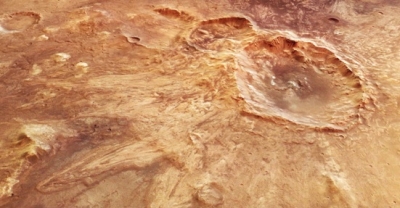
In the southern highlands of Mars lies a massive impact crater. About 2,300 kilometres wide, it is one of the largest in our solar system. With a basin floor lying more than seven kilometres below the Martian surface level, it is the lowest region on the planet. This is the Hellas crater, and the plain inside it is Hellas Planitia. Hellas is the Greek word for “Greece,” and Planitia is Latin for a “flat surface”.
To astronomers of the late 1800s looking through their low-powered telescopes, Hellas was a huge light-coloured region that stood out against the rest of Mars’ dark-coloured southern side. They mistook the paler area for a continent, and the darker part for seas!
Scientists believe that the Hellas crater was formed when a large space rock hit Mars around 4 billion years ago. The crash was so massive that the debris can be found up to two kilometres beyond the walls of the crater!
Radar images taken by the National Aeronautics and Space Administration’s (NASA) Mars Reconnaissance Orbiter indicate that there may be water-ice in Hellas Planitia hidden under a thin layer of dirt and rock. We can also find sand dunes in the basin with squiggly lines on its sides. These are linear gullies, believed to have been created by blocks of dry ice (frozen carbon dioxide) rolling down the dune slopes!
Picture Credit : Google




